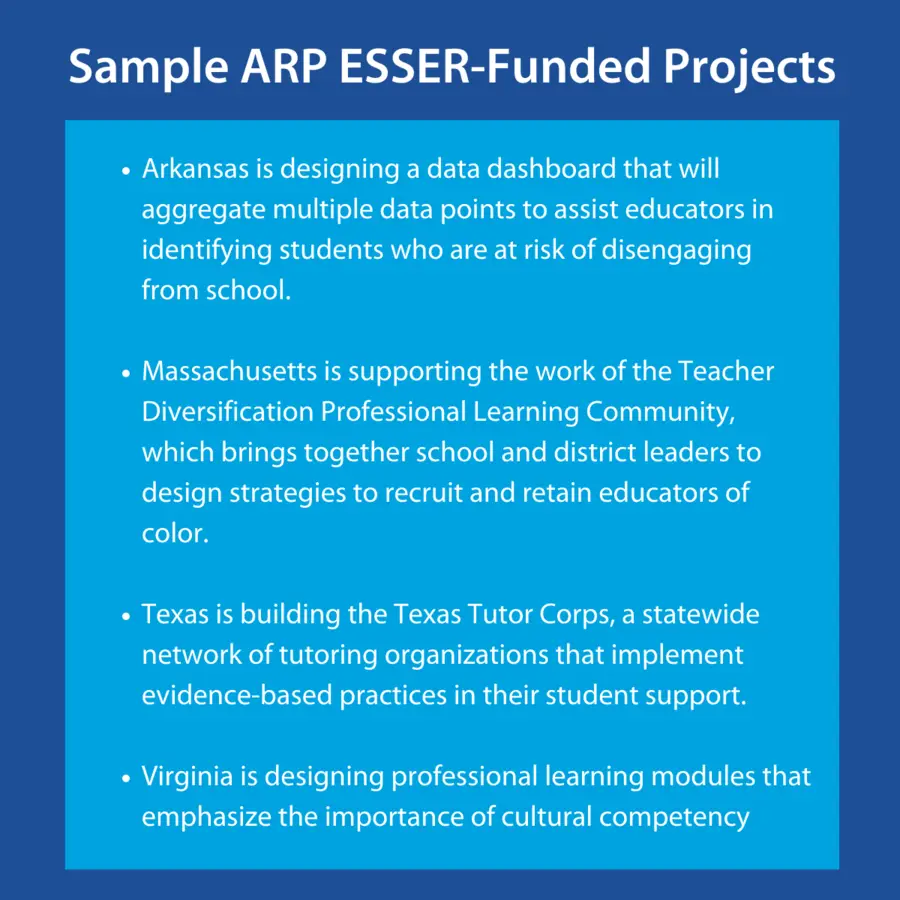Since late spring, state education agencies have been submitting plans to the federal Department of Education on how they intend to spend their share of the nearly $122 billion made available through the American Rescue Plan Education and Secondary School Emergency Relief (ARP ESSER) funding. ARP ESSER funding fuels the efforts of states and local school districts to resume in-person instruction and address students’ social, emotional, mental health, and academic needs as the nation recovers from the pandemic.
How Schools Plan to Use ARP ESSER Funding
State education agencies aim to use the ARP ESSER funding solve the unique challenges faced by students and educators in their communities, often leading to very diverse approaches to educational improvement. However, reviewing the approved state plans for how states will spend ARP ESSER funding illuminates a new reality. From coast to coast, from rural farms to urban metropolises, from students in pre-kindergarten to those graduating from high school, states are seeing similar opportunities to address key student and educator needs. States are united in their focus on using the ARP ESSER funding in several key areas:
- Social and emotional wellbeing of students and staff
- Opportunities to accelerate learning for students, both to address gaps that emerged during COVID-19, as well as those that have been in existence since before the pandemic
- High-quality instructional programming for students who participate in summer and after-school learning experiences
- Creation of safe and healthy learning environments that, to the extent possible, allow students to attend school in-person
- Reconnection with students and families who have become disconnected from the K-12 education system during the pandemic
- Increase in equitable access to technology (both devices and internet access).
An Evidence-Based Approach to State Plans for ARP ESSER Funding
States are required to use the ARP ESSER funding to implement evidence-based education interventions to enhance student learning, with specific educational relief funding for the use of evidence-based strategies in after-school and summer enrichment opportunities. While they are tackling priority needs in unique and diverse ways, an analysis of the approved state plans does reveal some shared approaches, including:
- Increased investment in statewide data systems to provide educators with access to real-time data they can use to personalize instruction for students and identify those at risk for academic disengagement
- Use of tutoring to address the needs of students affected most by the pandemic, along with professional learning for those serving as tutors
- Increased availability of mental health services in schools
- Professional learning experiences for teachers that focus on culturally relevant instruction, literacy, social and emotional learning, the use of data to inform instruction, and the effective use of technology in the classroom
- Improved analysis of attendance data and new programs designed to build relationships with disengaged students
- Development of strong partnerships between schools, community organizations, and after-school/summer program providers
- Identification and funding for evidence-based after-school and summer program providers (districts, community organizations, etc.) that embed mental health support for students and academic acceleration into their student experiences
- Support for students with the transition from high school to postsecondary opportunities and the workforce
- Creation of in-person and virtual opportunities for teachers to share resources and effective practices in professional learning communities
- Funding for innovative approaches to increasing, and diversifying, the teacher pipeline in the short- and long-term
The box below provides specific examples of some of these efforts.
State-Level Plans for the Use of ARP ESSER Funding
As comprehensive as they are, the areas of focus and ARP ESSER funding initiatives described above do not include the state-level plans for the use of ARP funding. In accordance with the requirements of the ARP, each state education agency must pass along at least 90 percent of its ARP funding to its local education agencies. This requirement means district leaders across the nation will work with their communities to determine how to spend over $109 billion! It’s clear that, over the next three years, ARP ESSER funding will power innovative work to improve learning at the state and local district levels.
If you have more questions about ESSER funding and would like to consult with RTI International on the use of your school’s ESSER Funds, contact Jennifer Preston.


